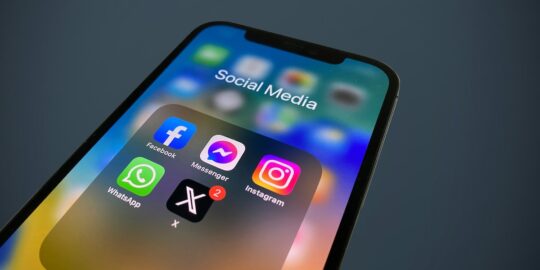
The education system continues to evolve away from the old-school “cells and bells, chalk and talk” model, with its compartmentalized classrooms and rigid pedagogical frameworks. Its aim now is to provide learning environments and curricula that will equip students for the demands and opportunities of the 21st Century. Australian Council for Educational Research Chief Executive Geoff Masters identifies “communicating, creating, using technologies, working in teams and problem solving” as some of the core skills that will best prepare students for work and life in the Digital Age. So, it stands to reason that the hallmarks of the 21st Century classroom are technology and collaboration.
The children currently in the school system, the Gen Z and Gen Alpha cohort, are “accustomed to new technologies and are always eager to learn new skills and discover fun activities.” In-classroom technology has to appeal to their curious dispositions and stimulate sustained interest and engagement. But then, it’s not just about the students. These kids might’ve grown up with digital technology, but many of their teachers did not. As a result, it’s likely that a teacher and their students will use technology and consume information in very different ways. The technology solutions they use together have to reconcile these differences, providing for seamless interactions between everyone in the classroom.
In this context, choosing the best technology solution has become a central concern for teachers and e-learning managers. It’s now a fundamental step in designing an effective learning environment and preparing kids for the future.
Vivi, the first wireless presentation platform to be developed specifically for learning environments, provides a great example of how choosing the right technology solution can help educators keep their students engaged and deliver those 21st Century learning outcomes.
How Vivi nurtures 21st Century learning
The frustration of trying unsuccessfully to connect a computer to a display is common in homes and workplaces, not just education settings. But when it’s a teacher that’s crouched awkwardly under a desk, fiddling with plugs and cables, it doesn’t take long for their students to lose focus and start acting out. It’s a classic example of technology getting in the way of learning, rather than facilitating it.
Vivi’s wireless presentation technology not only does away with those plugs and cables, it allows teachers and students to mirror their devices seamlessly to large, shared displays. It does this no matter what device is being used – desktop, laptop, tablet or smartphone; Apple, Windows, Chrome or Android – as long as the Vivi app is installed. And, although Vivi’s technology is incredibly powerful, for students and teachers, it’s as good as invisible, so the focus is always on learning.
Allowing students to share their work so easily, to express their ideas, receive feedback from their peers and provide feedback to others, encourages creativity and critical thinking, and builds self-esteem. The Vivi platform facilitates this sharing, while leaving control over what is shared safely in the hands of the teacher. And having been designed especially for schools, it includes a long list of pedagogical, functional and administrative features and benefits geared towards delivery of a truly 21st Century education.
Vivi’s Pedagogical Benefits
TEACHER MOBILITY
Studies have shown that students are prone to getting “on with things when the teacher’s gaze is on them, dropping off when attention switches elsewhere”. So, when an educator can teach from within the classroom, in amongst the students, rather than being tied to a desk at the front the classroom, it fosters higher levels of student engagement.
Vivi enables teachers to control what’s displayed on the shared screen from a phone or tablet, anywhere in the room, even if they’re also logged in from a computer. This mobility means that the teacher can move around the classroom, encourage and guide students, and assess their progress, while remaining in control of the room and the screen.
STUDENT PARTICIPATION
Research cited recently in Teacher magazine indicates that today’s students are likely to have “17 jobs over five different careers after they leave school.” It’s an incredible statistic, and to be able to adapt to those different roles and professional contexts, they’ll need to have well-developed skills of creativity, critical thinking, collaboration, and communication – the same skills that are nurtured and shaped within the technologically enabled, 21st Century classroom.
Active student participation is central to this, because it allows students to practice their skills in a controlled and positive environment. When students present their own ideas to their class, they get immediate peer and teacher feedback, giving them a sense of achievement and recognition, and encouraging reflection on the areas where they need to do more work. It also inspires healthy competition, which can motivate students to work harder and stay engaged.
Vivi facilitates all of this by providing such a simple and efficient solution for sharing work, one that keeps lessons flowing and minimizes interruption and distraction. An additional feature within the Vivi app, called Capture Screenshot, supports student engagement even further, particularly for those students who tend to be passive in class. Capture Screenshot allows students to take a screenshot of any media and annotate it, making it easier for them to be active pursuers of educational content rather than passive receivers of information.
TEACHER CONTROL
It’s important to not get too idealistic about the 21st Century classroom. After all, as any teacher will tell you, kids will be kids no matter what year it is or what incredible technology is available to them. While Vivi has been designed to open the classroom up to input from everyone, it leaves ultimate control with the teacher. They can instantly reclaim the display at any time, averting situations where a student is tempted to misuse the platform or present inappropriate content to their classmates.
STUDENT COLLABORATION
To equip today’s students for future success, “learners will need skills like analysing, evaluating and synthesising information and problem solving”, in combination with the fundamental social and emotional skills required for working effectively with others. This particular skillset is cultivated by active collaboration, where students learn to overcome challenges and solve problems together, despite different points of view and conflicting opinions.
Using Vivi’s wireless presentation technology, students are able to “break out” into small groups working around separate screens in the same classroom, for exercises in collective problem-solving. In this configuration, the smaller groups can work through challenges together, in a controlled environment that encourages them to show respect for their peers, to cooperate and to negotiate.
VISIBLE LEARNING
We know that the abundance of paperwork can be one of the great challenges of teaching. Vivi reduces this workload by facilitating visible learning. In a Vivi-enabled classroom, the teacher can work much more closely with their students, monitoring progress on an ongoing basis and assessing outcomes without the need for so many paper-based assignments. This in turn means less time spent marking and more time in the classroom making assessments in real-time. And of course, teaching.
CLASSROOM EFFICIENCIES
The worst thing in-classroom technology can do is add tasks to a teacher’s day. Vivi does the opposite, creating efficiency through a range of features built specifically for the school environment.
Some are beautifully simple, such as the Share Link with Room feature, which allows teachers to simultaneously broadcast a URL to the entire class. Or the digital alert a student can raise instead of raising their hand, so they can let the teacher know they’d like to speak to them but then continue working until the teacher is free. Others are more sophisticated, for example, real-time classroom participation metrics that enable teachers to track the level of student engagement at all times.
But it might be Vivi’s management of video that excites teachers the most. After all, video can be such a powerful tool in education, but it’s also notorious for derailing classes with poor performance and incessant buffering. Vivi mitigates that risk by offering a direct video play feature within the App and integration with video management systems such as Clickview. And while a teacher is playing video to a shared screen from their own device, everything else doesn’t have to stop – they’re free to continue their own work privately on that same device.
Vivi’s Functional Benefits
VIDEO CONTENT
As we’ve seen, video has been given special consideration on the Vivi platform, with the aim of giving teachers the ability to stream video from any online source, seamlessly. This includes high-definition videos, which can be streamed in Vivi’s Direct Video Play mode without any buffering or latency (the delay between streaming and display).
Like Vivi’s other features, video can be controlled from anywhere in the room, meaning the teacher can pause or fast-forward video playback while sitting amongst their students, or moving around the classroom.
CLASSROOM SETTINGS
Flexibility and control are important in any school setting, but particularly when dealing with a wireless presentation system and a classroom full of students. Consider the teacher who wants to share one student’s exceptional work as a guide or inspiration for the rest of the class, but doesn’t want those other students to go away and copy it. By turning on Vivi’s Privacy Mode, the class can view the work being displayed but can’t take a screenshot for later reference. It’s a simple measure, but one that neatly preserves the integrity of the learning process.
In other circumstances, that teacher might want to hand responsibility for managing access to the shared display to the students themselves. This is particularly important in senior school grades, where building responsibility and trust is so important. By switching the classroom into Open Access Mode, every logged-in student is given presenter-level access, so they’re free to present to their classmates … which is precisely where those 21st Century skills of communicating, working in teams and problem-solving need to kick in!
BYOD (Bring Your Own Device)
There are good reasons why 1:1 implementation, such as BYOD has become a popular approach for dealing with technology in 21st Century learning environments. For example, it can be reassuring for teachers and students to use their own device, and it eliminates the time otherwise spent teaching an entire class how to use the supplied equipment. But connecting so many different devices to a school IT system can be challenging.
Vivi wireless presentation technology overcomes that with simple, native mirroring of any computer or mobile device that has the Vivi app installed, Apple, Windows, Chromebooks or Android. So the only reason a student couldn’t participate in the classroom would be if they’d left their device at home. (Yes, it’ll happen, but considering the nature of most devices, at least their teacher won’t have to put up with any more “the dog ate my homework” excuses!)
FUTURE-PROOF SOLUTION
Because the bulk of Vivi’s intelligence is concentrated in its software, updates and maintenance are simple to manage. This is due to Vivi’s Hardware Enabled Software as a Service business model (HESaaS), where the hardware is the medium through which the benefits of the software are realized. The platform itself is constantly being developed, not only to ensure that it supports the latest mobile devices and operating systems, but to respond to the changing needs of the 21st Century classroom with new features and tweaks to functionality.
In effect, Vivi is always at the cutting-edge and all of its users benefit from that. At the same time, teachers and students in 1:1 environments contribute to the system by incrementally upgrading their own devices. It’s a far cry from the old model of committing to a large upfront investment in technology and accepting its inevitable, impending redundancy!
And because Vivi’s “display agnostic” technology works with any projector or LCD screen from any manufacturer, the system can develop and grow via regular software updates with no need for new presentation equipment. As each projector and screen reaches the end of its useful lives, it can simply be replaced as normal.
Vivi’s Administration Benefits
VIVI CENTRAL
One of most attractive aspects of Vivi for eLearning or IT managers is the centralized management functionality built into its administration platform; Vivi Central. From Vivi Central, the school’s entire Vivi network can be managed: bulk firmware updates can be run from it; IT staff can pick up and respond to maintenance notifications sent from teachers in individual rooms; custom splash screens with school logos or other images can be assigned; and administrators can monitor usage at a group or individual level, track files and devices within the school’s private network, and authorize access to data.
So the entire Vivi network is integrated, with whole-of-school management functionality channelled through this single platform, which can be accessed seamlessly by user login. By comparison, the traditional model for school technology, with its emphasis on hardware over connected software, is fragmented, unwieldy and inefficient.
USER ANALYTICS
As with all systems and processes, Vivi’s performance relies on buy-in from the teachers and students who use it. The Analytics Dashboard is a powerful tool that collects data about levels of adoption across the teaching staff, and gives eLearning and IT managers detailed insights into usage. This information can then be used to identify the teachers who are embracing Vivi and those who may need additional encouragement or professional development. At the same time, Vivi’s student dashboard provides data and insights with regard to the students’ adoption and usage of the technology.
OCCUPATIONAL HEALTH AND SAFETY
Vivi’s network of connected devices and displays can be harnessed for purposes outside its core educational purpose. In the event of a crisis, for example, Vivi’s Emergency Broadcast feature allows for evacuation and lockdown messages to be broadcast instantly into all Vivi-connected rooms. This provides additional guidance to teachers in these challenging scenarios, and can remind the entire school population of all necessary safety procedures. It’s a feature that everyone hopes is never needed, but it’s certainly reassuring to have it there just in case.



